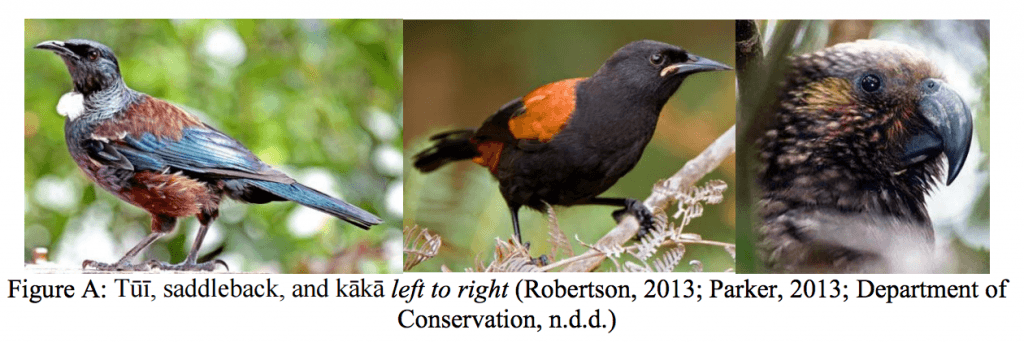Executive Summary
Once known as a “bird land,” New Zealand was home to bird species unlike anywhere else in the world (ZEALANDIA, 2016b). Unfortunately, the introduction of foreign species and clearing land for farming by European settlers in the late eighteenth to early nineteenth century caused extensive damage to the native ecosystem. Whether by predation, competition, or habitat destruction many endemic species are now endangered or have gone extinct. ZEALANDIA, a wildlife sanctuary in Wellington, is working to restore native species by increasing public awareness of birds and conservation efforts. To help build awareness of conservation efforts in Wellington, the Wellington City Council coordinates with the sanctuary to involve the community in outreach and education initiatives to further protect native species (Wellington City Council, 2012). The Wellington City Council provides funding for ZEALANDIA’s projects and appoints trustees who work closely with the sanctuary (ZEALANDIA, 2016b). This partnership enables both organizations to rebuild native bird populations and to involve the public in pest eradication efforts. The goal of this project was to assess public awareness and knowledge of native bird species in the Wellington metropolitan area. Threatened birds of interest fell into three categories: Nationally Critical, Nationally Endangered, and Nationally Vulnerable. The study focused on the tūī, saddleback, and kākā, pictured below in Figure A. These birds were chosen because they spanned conservation threat levels.
Methodology
Results and analysis
Recommendations
Conclusions
Methodology
We evaluated educational materials, including signage, pamphlets, exhibits, and posters in ZEALANDIA. We also assessed residential neighborhoods that abut the sanctuary (the socalled ‘halo district’) to gauge interactions between humans and birds. A summary of our approach can be seen in Figure B.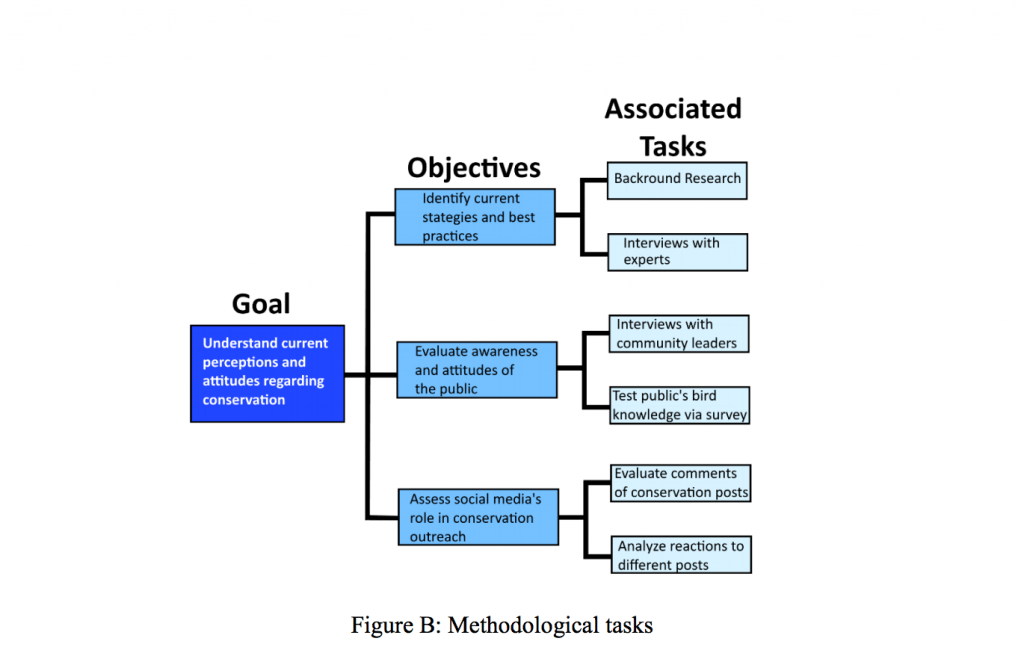 In order to assess public awareness, knowledge, and attitudes, we conducted a survey of residents from the Wellington metro area. The survey included questions on bird recognition, kākā feeding habits, attitudes to nature. The Wellington City Council and ZEALANDIA use social media outlets to reach a broad audience on topics of conservation and to rally support within the community. We assessed comments on social media posts qualitatively for tone and content. We identified patterns and trends among responses. From our findings we determined the general relationship between social media and public perceptions and knowledge.
In order to assess public awareness, knowledge, and attitudes, we conducted a survey of residents from the Wellington metro area. The survey included questions on bird recognition, kākā feeding habits, attitudes to nature. The Wellington City Council and ZEALANDIA use social media outlets to reach a broad audience on topics of conservation and to rally support within the community. We assessed comments on social media posts qualitatively for tone and content. We identified patterns and trends among responses. From our findings we determined the general relationship between social media and public perceptions and knowledge.
Results and analysis
<p Our data revealed positive news about area respondents. The 418 respondents were from 60 Wellington suburbs with 48% (200) from the halo region. The survey was taken by 38% males and 62% females with 42 being the average age of survey respondents. Over half the participants indicated they had a bachelor’s degree as their highest level of education. Out of all the respondents, 4% identified as Māori or Pasifika. In regards to the nature-relatedness scale, 82% identified with the upper bounds of the scale indicating they feel more connected to nature. Our bird identification test found high success rates even though we intentionally included more species that might be more difficult to recognize. The tūī was recognized and named correctly by almost 99% of respondents. The saddleback, which we expected to be the most difficult to identify, was identified 76% of the time. The common sparrow, despite what its name may imply, was only identified by 87% of respondents. The kākā was identified by 85% of participants possibly because of its resemblance to the kea, another native parrot which is slightly smaller than the kākā (Figure C).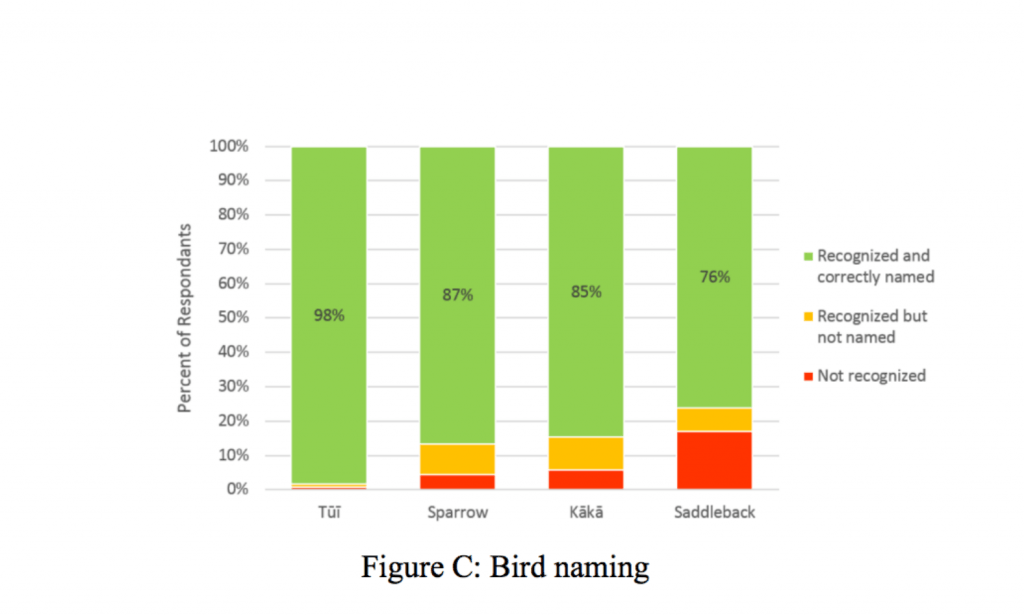 When identifying native birds, the tūī again received the most correct responses at 99% and the common sparrow was the most difficult for respondents in this case, with 13% unable to state it was a non-native bird. Although there were 13% of respondents who could not properly identify it as non-native, this score is reasonably low. Below are the results of responses identifying birds as native (Figure D).
When identifying native birds, the tūī again received the most correct responses at 99% and the common sparrow was the most difficult for respondents in this case, with 13% unable to state it was a non-native bird. Although there were 13% of respondents who could not properly identify it as non-native, this score is reasonably low. Below are the results of responses identifying birds as native (Figure D). Participants were also asked to name what visual features helped them recognize each bird and responses are represented via word cloud (Figure E).
Participants were also asked to name what visual features helped them recognize each bird and responses are represented via word cloud (Figure E).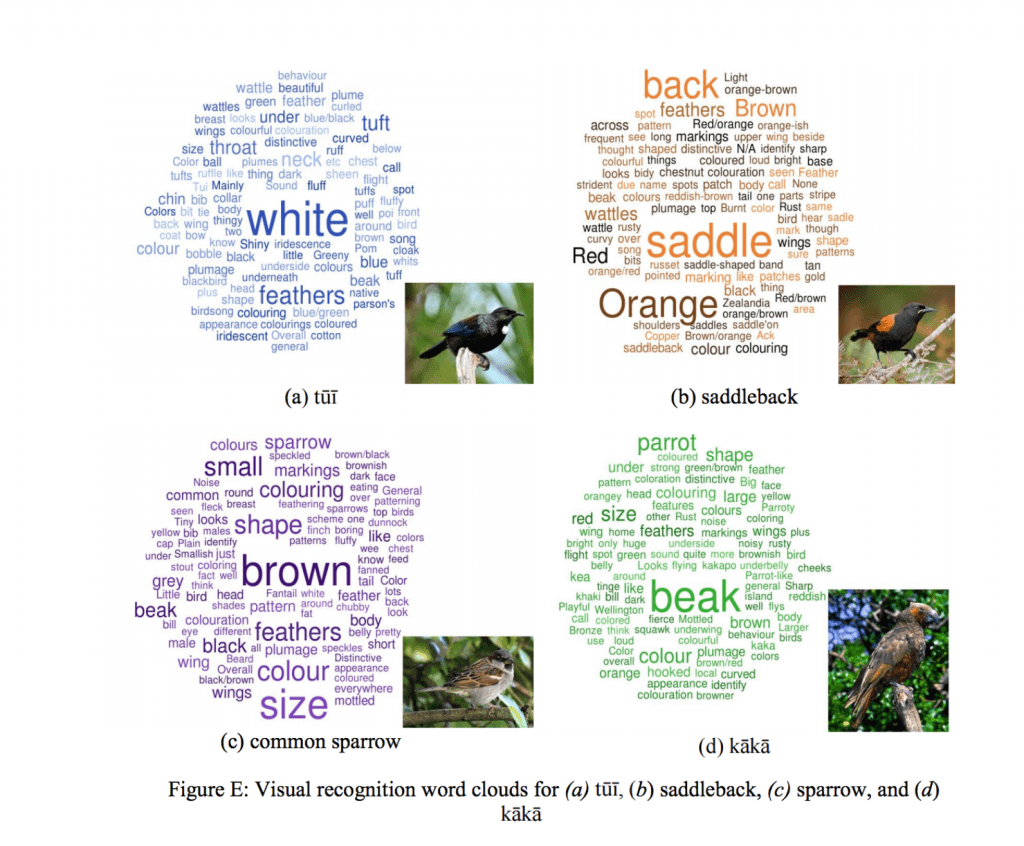 There was no significant difference in bird recognition between halo and non-halo residents. Halo residents who scored above 87.5% made up 77.6% of the population whereas non halo residents in the same category made up 74.2% of the population. We were encouraged to find that the percentage of people feeding kākā has declined from 19% to 4% in 2017, and we assume that this decline is a result of educational efforts and ongoing coverage by the media about this issues (Figure F). Furthermore, it appears that those who are still feeding the kākā are following the guidelines “Feeding Birds at Home” put out by ZEALANDIA, which may reduce the harms that might result from inappropriate feeding. Ideally, no members of the public would be feeding kākā.
There was no significant difference in bird recognition between halo and non-halo residents. Halo residents who scored above 87.5% made up 77.6% of the population whereas non halo residents in the same category made up 74.2% of the population. We were encouraged to find that the percentage of people feeding kākā has declined from 19% to 4% in 2017, and we assume that this decline is a result of educational efforts and ongoing coverage by the media about this issues (Figure F). Furthermore, it appears that those who are still feeding the kākā are following the guidelines “Feeding Birds at Home” put out by ZEALANDIA, which may reduce the harms that might result from inappropriate feeding. Ideally, no members of the public would be feeding kākā.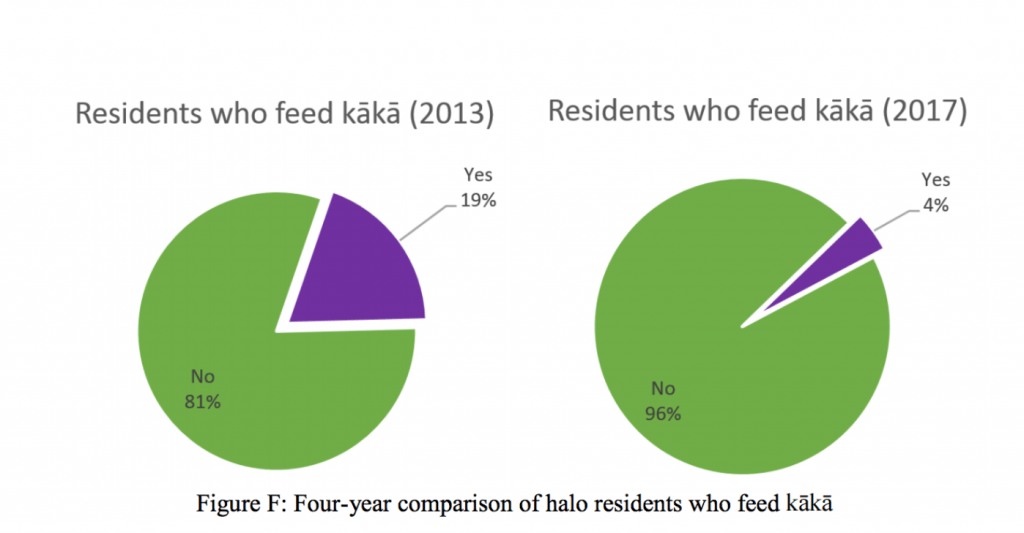 From conversations with experts we conclude that hands-on programs may be the best way to engage the public. It was also clear from our discussions that presenting a compelling narrative is key. Negative articles and posts on social media that discourage particular activities are not received well and most residents disregard the suggestions. Narratives that play on emotions and create connections between birds and people are much more effective and help to spread awareness further.
From conversations with experts we conclude that hands-on programs may be the best way to engage the public. It was also clear from our discussions that presenting a compelling narrative is key. Negative articles and posts on social media that discourage particular activities are not received well and most residents disregard the suggestions. Narratives that play on emotions and create connections between birds and people are much more effective and help to spread awareness further.
Recommendations
At the conclusion of our assessment, we developed two tiers of recommendations for the Wellington City Council and ZEALANDIA to contribute to their endeavors for conservation outreach and community engagement.1. Social media platformsIn our research we discovered that social media can boost messages and get them to a broader audience faster. Some platforms such as reddit allow for a much more interactive information source. The WCC and ZEALANDIA can use reddit as a means to create an ongoing conversation between their organizations and the public. Given our group’s background in reddit and the surprisingly enthusiastic and engaging comments we received on our survey distribution post, we are very optimistic about the possibility of the Wellington City Council and ZEALANDIA using reddit as a community engagement platform. The /r/Wellington subreddit community is especially fond of their city, so it is not too far-fetched to speculate that the community would welcome WCC and ZEALANDIA with open arms. The format reddit provides with its forum-based structure allows for much more “intimate” conversations with individuals, and can be an effective way to receive in-depth qualitative feedback. On reddit, everyone is a “user”, so WCC and ZEALANDIA would have to create reddit accounts, and would then be free to use basic reddit features (creating text and/or linked posts, commenting on posts, and being able to send and receive private messages). The upkeep on a reddit account would be simple enough for a student intern to manage part-time and report their discussions with the community to the council.In addition, we also recommend both WCC and ZEALANDIA further investigate the reactions of individuals to conservation Facebook posts. As discussed, tracking the trends of individual users on Facebook is not currently possible. However since Facebook was the most popular choice in our survey when we asked participants to name their conservation news outlets we feel it is worth working around this shortcoming. Using a program similar to the one which we outlined in our discussion, both organizations could get a better understanding for what reactions their posts create in the community. With this information they could better cater their posts to encourage locals to get involved rather than viewing the post and disregarding the importance the message carries.2. Community outreachIn addition to expanding social media efforts, one way to encourage mindfulness of native birds could involve a wristband sponsorship program. Many of the birds in the sanctuary are tagged with colorful bands by researchers in order to track them. We developed an idea for creating colored silicone wristbands as part of the program to match that of the birds in the sanctuary. As discussed previously, we have found engaging experiences tend to be the most successful for raising awareness. These wristbands provide an interactive way for individuals to make a connection with some of the native birds inside the sanctuary as well as be a method of fundraising (Figure G).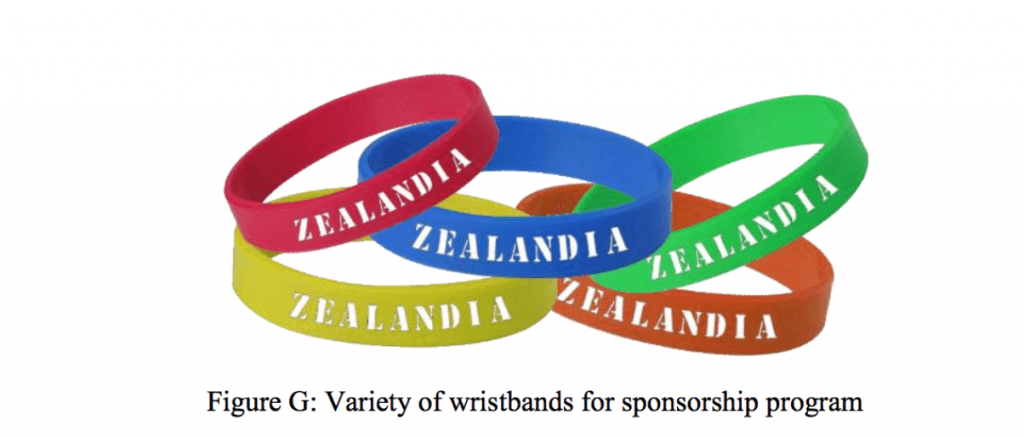 The funds raised by this program could be used to cover its own initial startup but also could be used as a standalone fundraiser for ZEALANDIA in order to maintain the sanctuary.The word clouds we created from the data in our survey responses could prove useful for future conservation outreach campaigns. The common features that many used to help identify the birds could be used by a digital artist to make designs that catch the eyes of the public. Simple artwork like this could be used in a variety of awareness programs such as a pre-field trip program to ZEALANDIA where they are used as learning flashcards, creating street art, partnering with local businesses to incorporate designs into their products, or games.We encourage that WCC continues working with reputable groups, such as ZEALANDIA, and local schools to maintain clear consistent recommendations around bird conservation efforts. The Wellington City Council is excellent in ensuring a consistent message between organizations during conservation campaigns, so we recommend they continue this strategy for future efforts because the community could greatly benefit from a consistent voice.
The funds raised by this program could be used to cover its own initial startup but also could be used as a standalone fundraiser for ZEALANDIA in order to maintain the sanctuary.The word clouds we created from the data in our survey responses could prove useful for future conservation outreach campaigns. The common features that many used to help identify the birds could be used by a digital artist to make designs that catch the eyes of the public. Simple artwork like this could be used in a variety of awareness programs such as a pre-field trip program to ZEALANDIA where they are used as learning flashcards, creating street art, partnering with local businesses to incorporate designs into their products, or games.We encourage that WCC continues working with reputable groups, such as ZEALANDIA, and local schools to maintain clear consistent recommendations around bird conservation efforts. The Wellington City Council is excellent in ensuring a consistent message between organizations during conservation campaigns, so we recommend they continue this strategy for future efforts because the community could greatly benefit from a consistent voice.
Conclusions
The ZEALANDIA sanctuary’s safe haven for native wildlife is a promising step towards restoring the populations that were destroyed through the settlement of the country. Residents abutting the sanctuary in the region known as the halo therefore are tied to the success of this revival. Programs to educate and involve these individuals to understand and help protect these birds to ensure their return to the area are vital. Through our research we have uncovered that Wellington residents find themselves strongly influenced by nature and are familiar with the native birds that share the area with them. We also have a better understand for how these residents receive their information when it comes to these topics. Increased efforts to utilizing these sources to involve even more of the public would accelerate the progress being made.With the recommendations we have put forth, WCC and ZEALANDIA stand to both optimize their current outreach programs and target newer and unexplored audiences. Reaching younger demographics through social media will be the foundation of an educated society that emphasizes conservation first when making decisions that will impact the environment.



